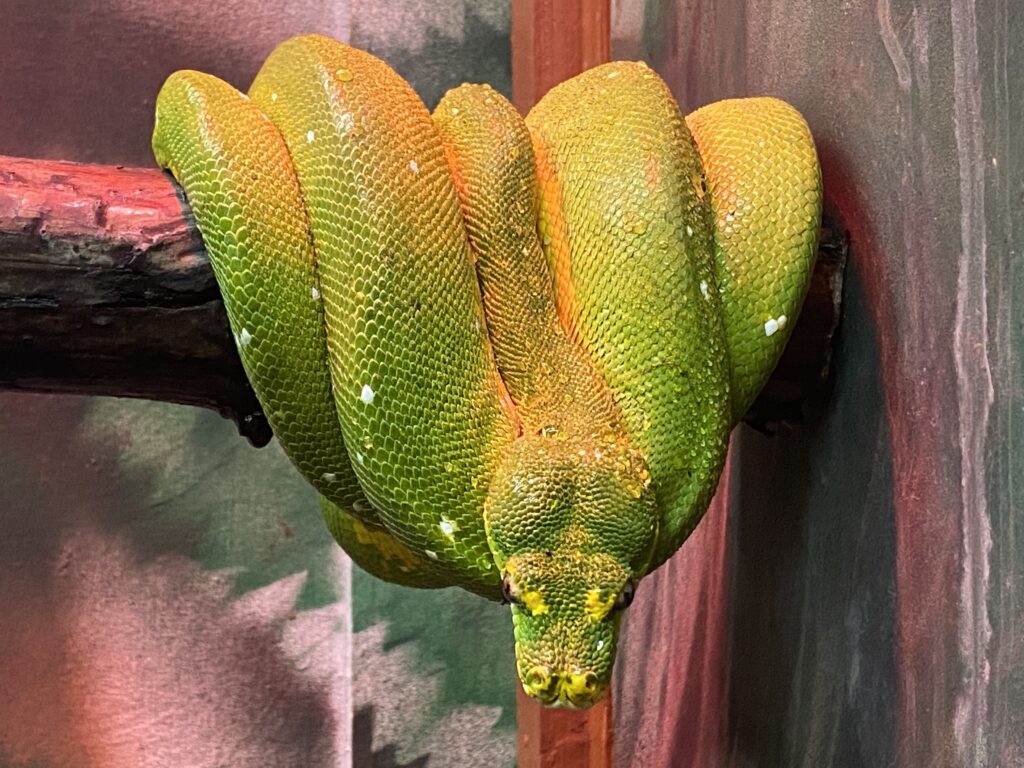Kingdom: Animals
Phylum: Chordata
Class: Reptilia
Order: Squamata
Suborder: Serpentes
Family: 18
Species: about 2,900
Snakes are highly evolved predators. They have no limbs, no eyelids, and no external ears. They can move with ease and find their prey using sophisticated senses. All snakes eat other animals, from ants to antelope. Snakes can not chew their food, but the bones in their skull are lightly constructed and loosely connected so the jaws can open wide and they swallow their prey whole. The snake will have up to 400 vertebrae that articulate on each other to give a highly flexible skeleton. Snakes kill their prey using different methods. Some snake species will swallow their prey alive while others constrict their prey before swallowing it. Other snakes produce venom and strike their prey quickly, waiting for the venom to take affect before eating their meal.
Colubrids:
Order: Squamata
Suborder: Serpentes
Superfamily: Caenophidia
Family: Colubridae
Species: 1,858
Corn Snake
Range: Southeast and Central USA
Habitat: woods, grasslands, urban
Conservation Status: Common
Scientific Name: Elaphe guttata
The corn snake is an eye catching rat snake. Corn snakes can be found on the ground, on the trees or buildings. Adult corn snakes feed mostly on rodents and are very useful around farms. If caught, they excrete a foul smelling musk. They can lay up to 25 eggs in decaying vegetation. Also called the red rat snake, the corn snake is named for its checkered belly, which reminded the early colonists of multicolored Indian corn. Corn snakes do well in captivity and are often kept as pets. Color mutants are often available, and quite popular, in pet stores. Two common mutations are anerythrism (a lack of red pigment that produces a gray body) and albinism (a lack of melanin, resulting in a bright reddish-orange body). They can grow up to 2 ½ to 4 feet long. In the wild they will eat young rats, mice, birds, lizards, and frogs. Our corn snake is ready for viewing in the Herpaquarium.

Green Tree Python
Order: Squamata
Suborder: Serpentes
Superfamily: Henophidia
Range: New Guinea and extreme Northern Australia
Habitat: Forest
Conservation Status: Locally Common
Scientific Name: Morelia viridis
The Green Tree Python has adaptations for living in the trees. It is slender, has a prehensile tail, and its green coloration is great camouflage amongst the leaves. It will coil up on top of a branch with its head hanging down ready to strike at prey. Green Tree Pythons have heat pits around their mouth which aid in “seeing” prey in the dark by detecting infrared radiation from warm bodies. Females will lay 6 – 30 eggs in a tree hole or among plants. The young are either bright yellow or red and are hunted by birds of prey. They get their green coloration at about one year of age. You can find our Green Tree Python in the Herpaquarium.
Pueblan Milksnake
Order: Squamata
Family: Colubridae
Range: Mexico
Habitat: High Desert
Scientific Name: Lampropeltis triangulum campbelli
The milksnake is not venomous. However, the Pueblan milksnake mimics the coloration, markings, and even behavior of venomous coral snakes and is easily confused with them in parts of its native range. This adaptation is a form of defensive mimicry. If disturbed or uncovered from its hiding place, the milksnake may thrash around in an attempt to startle its predators with its vivid colors. It can grow up to 3 feet in length. Milksnakes are found in the southern portions of North America, northern portions of South America, and throughout Central America. They live in arid portions of its native range and found at elevations exceeding 5500 ft. They eat small lizards and snakes, birds, mice and other rodents. You can find our Pueblan Milksnake in the Herpaquarium.
Russian Rat Snake
Order: Squamata
Family: Colubridae
Scientific name: Elaphe schrenckii
Range: The species is endemic to Northeast Asia (China, Korea, Russia, and Mongolia).
Habitat: Forest clearings, scrub, farmland
Conservation Status: Stable
As adults, Russian rat snakes are usually black or dark brown with yellow or cream bands. It can attain an adult length of 6 feet and has been known to occasionally reach 8 feet. When threatened, rat snakes will “rattle” their tail, fooling other animals into believing they are venomous. Rat snakes are constrictors, which suffocate their prey. These snakes are excellent climbers and hunt for birds and eggs in trees.
The species has not been assessed by the IUCN but is on the China Species Red List with a classification of “Vulnerable VU A2a”. It is an officially protected species in Russia and South Korea.
